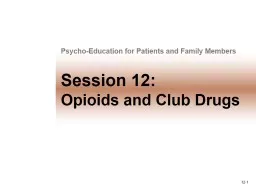

PsychoEducation for Patients and Family Members 12 1 The Importance of Total Abstinence Abstinence from all substances that affect the braineven alcoholgreatly increases the chances of a successful recovery ID: 911071
Download Presentation The PPT/PDF document "Session 12: Opioids and Club Drugs" is the property of its rightful owner. Permission is granted to download and print the materials on this web site for personal, non-commercial use only, and to display it on your personal computer provided you do not modify the materials and that you retain all copyright notices contained in the materials. By downloading content from our website, you accept the terms of this agreement.
Slide1
Session 12:Opioids and Club Drugs
Psycho-Education for Patients and Family Members
12-
1
Slide2The Importance of Total AbstinenceAbstinence from all substances that affect the brain—even alcohol—greatly increases the chances of a successful recovery.12-2
Slide3Questions:What do you know about opioids?What do you know about heroin?1-3
Slide4What Are Opioids?Examples of opioids are:Heroin (natural opioid)Morphine (natural opioid)Meperidine (synthetic opioid)Oxycodone (synthetic opioid)Opioids act on the brain’s opiate receptors.Opioids dull pain and relieve anxiety that comes from thinking about pain.People abuse opioids because they provide a feeling of euphoria (a “rush”).12-4
Slide5Physical Effects of OpioidsTaking opioids causesConstricted pupilsFlushing of the skinHeavy feeling in the limbsThe rush is followed by a confused, drowsy feeling that lasts several hours.Breathing and heart rate slow during this period.12-5
Slide6Question:What is “tolerance” to drugs?1-6
Slide7Opioids and Tolerance Higher and higher doses are required to achieve the opioid’s effects. This is called “tolerance.” Eventually, the drug is taken mainly to prevent withdrawal, not to get high. 12-7
Slide8Question:What are “dependence” and “addiction” on drugs? How are they different?1-8
Slide9Dependence and Addiction on Opioids Repeated use of opioids can result in dependence and addiction.“Dependence” causes withdrawal symptoms to the person’s body when he/she stops using a drug.“Addiction” is characterized by craving for the drug and using it even when it causes harm.People who use opioids as prescribed to relieve pain may develop dependence but rarely become addicted.12-9
Slide10Withdrawal From OpioidsWithdrawal occurs when someone who is dependent stops taking opioids suddenly. Withdrawal symptoms: severe muscle and bone pain, trouble sleeping, diarrhea, vomiting, and cold flashes.Withdrawal can take up to a week to run its course.Withdrawal from opioids can be fatal, but a death rarely happens to healthy adults.12-10
Slide11Abuse of Prescription OpioidsThe main prescription opioids people abuse are:MorphineMeperidineNalbuphine (Nubain)12-11
Slide12HeroinHeroin is a white to dark brown powder.It often is mixed with other substances (sugar, starch) or poison (strychnine). It is smoked, snorted or injected. Heroin users starting out smoking or snorting often progress to injection.12-12
Slide13HeroinThe need to purchase and use heroin causes people to ignore other aspects of their lives, like family and loved ones, finances, and legal concerns. This neglect can lead to weight loss, sickness, money problems, criminal activity, and housing and family problems.Overdose is a persistent danger with heroin.12-13Dangers
Slide14HeroinInjection drug use is linked to HIV cases and hepatitis C cases.Injecting heroin can lead to:Collapsed veinsClogged blood vesselsBacterial infections of the heart and blood vesselsPneumoniaTuberculosisLiver or kidney disease12-14Disease Risks
Slide15Question:What do you know about club drugs?1-15
Slide16What Are Club Drugs?Club drugs include a variety of drugs used at bars and dance parties, especially by high school and college students.Examples of club drugs are:MDMA (“Ecstasy”)LSDKetamineGHBRohypnolMany people wrongly believe club drugs are safe.12-16
Slide17MDMA or “Ecstasy”Ecstasy causes increased heart rate and blood pressure, nausea, loss of appetite, jaw tightness, and teeth clenching.Ecstasy also produces increased energy, desire for visual stimulation, and heightened awareness of and response to sensory input.After an initial rush, people experience calm, positive feelings lasting 3-6 hours.Ecstasy can raise the body temperature to dangerous levels (42 degrees C).Ecstasy kills nerve cells in the brain. Studies show that the damage can last at least 7 years.12-17